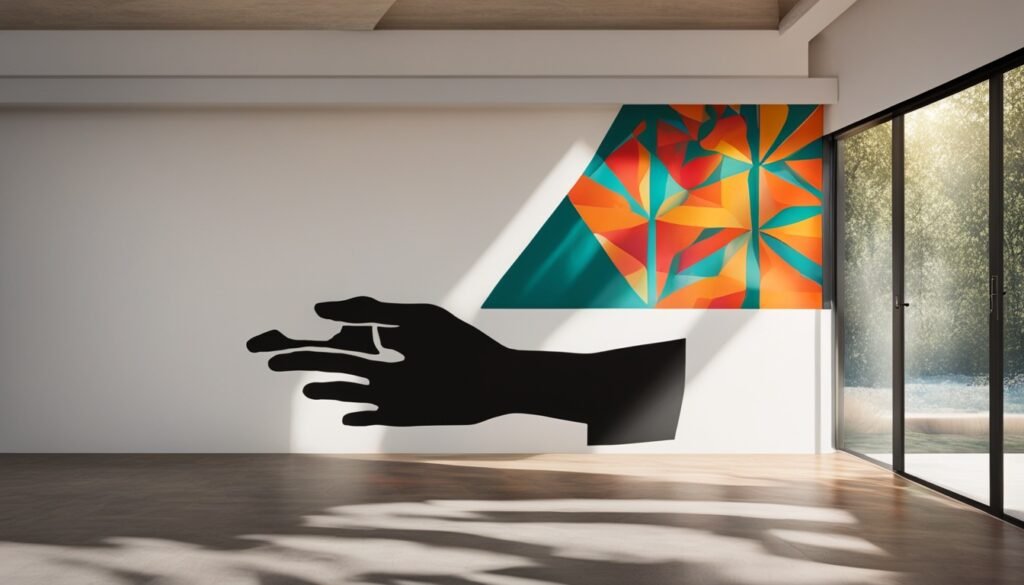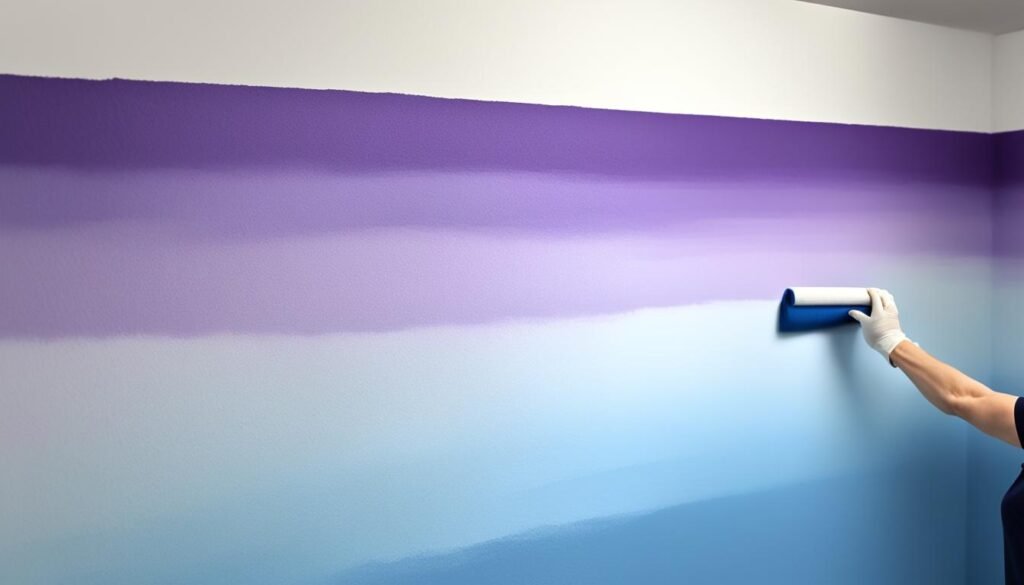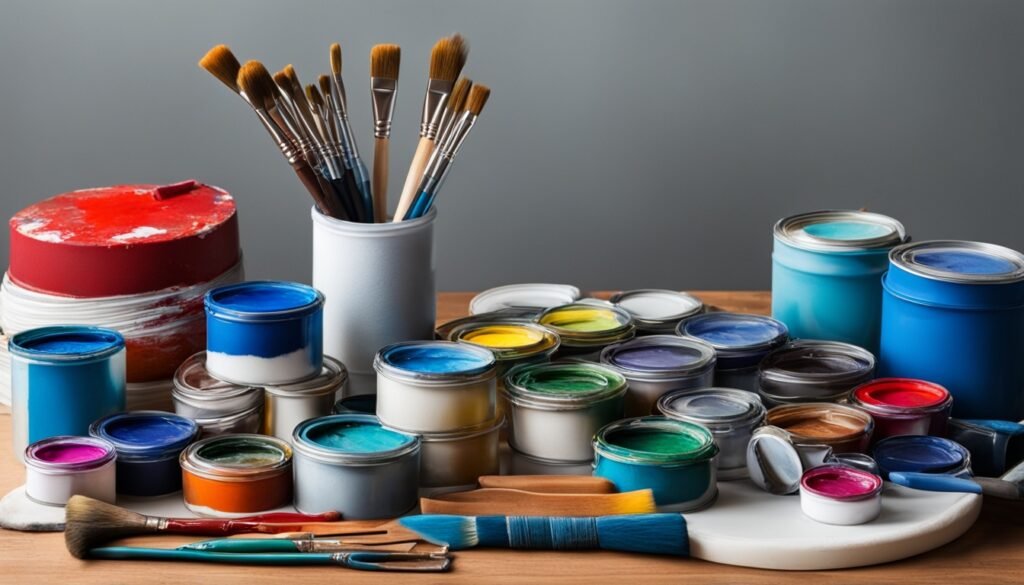Are you tired of looking at dull walls every day? Become your own artist and explore the power of DIY wall painting. You can add color, make a statement wall, or change your whole room. This lets you show off your unique style and make your home reflect you.
With the right skills and creativity, you can change your walls and make any room look new. Try bold colors, detailed stencils, or ombre effects. Let your inner designer shine and customize your space to match your taste.
Key Takeaways
- Discover the versatility of DIY wall painting to revitalize your living space
- Explore a wide range of wall painting techniques to express your creativity
- Learn how to prepare your walls for a flawless finish and choose the right wall painting supplies
- Embrace bold colors, patterns, and accents to create a truly unique and personalized look
- Discover the power of ombre walls and furniture painting to add depth and interest to your decor
Why DIY Wall Painting Is a Game-Changer
Make your living space look new with DIY wall painting. It’s a budget-friendly way to refresh your home. You can show off your artistic skills and make designs that are all your own.
Unleash Your Creativity
No more boring walls. DIY wall painting lets you play with colors, patterns, and textures. You can match your style and personality perfectly. Whether you like simple or bold designs, you can do it all.
Cost-Effective Transformation
Hiring pros can be expensive, making home makeovers hard for many. Interior wall painting is a cheaper way to change your space. By doing it yourself, you save on costs and feel proud of your work.
“DIY wall painting is a game-changer for homeowners looking to revitalize their living spaces without the hefty price tag of professional renovations.”
With the right wall painting techniques and wall painting ideas, you can make a space that shows off your style. The process of DIY painting is as fulfilling as the final look. It lets you take control of your home’s look.
Prep Work: The Key to Flawless Walls
Getting your walls ready before painting is key to a pro-looking, lasting finish. Spend time cleaning, patching, and priming to make a great base for your wall painting techniques.
Cleaning and Patching
Begin by cleaning your walls well. Use a mild soap and water mix to remove dirt, dust, or grease. This makes sure the wall painting supplies stick well.
Then, look for any spots that need fixing, like cracks or holes. Use a patching compound to fill them in, then sand smooth. Sanding makes the surface even, so the new wall painting colors don’t show old marks.
Choosing the Right Paint
Picking the right paint is crucial for a great DIY project. Think about the finish you want, like matte, eggshell, or satin. Also, consider the paint’s quality and how much coverage it gives. Using a good primer before painting boosts the paint’s adhesion and look.
| Paint Finishes | Ideal Use |
|---|---|
| Matte | Walls, ceilings |
| Eggshell | Walls, trim |
| Satin | Walls, trim, doors |
Good prep work is vital for perfect walls. Clean, patch, and pick the right wall painting supplies for your wall painting techniques and wall painting colors. This careful planning leads to a beautiful, lasting finish.
diy Wall painting Techniques to Try
Make your living spaces pop with easy DIY wall painting techniques. Try bold color blocking, intricate stencils, and patterns to show off your creativity. These methods let you refresh your home’s look without much effort.
Color Blocking
Color blocking means painting the wall in big, bold shapes or sections. It brings depth and modern style to any room. You can choose bright colors or softer shades, depending on what you like.
Stencils and Patterns
Stencils make it easy to get a pro look without being a pro. Pick your pattern, place the stencil, and paint for a unique design. You can go for classic stripes or fun polka dots, and more.
| Technique | Description | Difficulty Level |
|---|---|---|
| Color Washing | Adds texture and depth to walls with a glaze-like finish | Moderate |
| Metallic Finishing | Achieves a prismatic, high-sheen effect on walls | Challenging |
| Sponging | Uses a sponge to create dynamic, mottled textures | Easy |
| Strié Technique | Imitates the look of linen with vertical brush strokes | Moderate |

Let your creativity shine with these DIY wall painting techniques. Whether you choose bold colors or detailed stencils, you can make your walls stand out. It’s a great way to add a personal touch to your home.
Embracing Bold Colors and Accents
Changing your living space can be thrilling, and using bold wall painting colors is a great way to stand out. Whether you like deep, rich colors or bright greens, these colors can make your rooms feel new and set the mood you want.
Painting an accent wall is a smart way to add boldness. This can change the whole look of a room, making it the main focus. Try adding different textures or patterns to your accent wall for more depth.
If you’re up for a challenge, go for a unified look with wall painting designs across your home. Matching colors and patterns makes everything flow together beautifully. The trick is finding the right mix of contrast and harmony.
“Embrace the bold and the beautiful – your walls are a blank canvas waiting to be transformed.”
Don’t hesitate to try new things and show off your creativity. Whether it’s a bright green, a dark charcoal, or a fun pattern, wall painting colors can transform your space. They can make it truly reflect your unique style.
The Art of Ombre Walls
Looking to add elegance and depth to your space? The ombre wall painting technique is perfect. It blends two or more colors smoothly, creating a beautiful transition from light to dark. This adds interest and sophistication to any room.
Blending Colors Seamlessly
Mastering color blending is key for a stunning ombre wall. Paint chips help you pick the right colors. They let you see how the colors will transition. With some planning, you can make a gradient that will amaze your guests.
Creating Depth and Interest
Ombre walls bring elegance and depth to a room. By choosing your colors carefully and blending them well, you can turn a plain wall into a stunning focal point. Whether you choose bold colors or subtle tones, the ombre effect will make your space look better.
With the right wall painting techniques, wall painting ideas, and creativity, you can make ombre walls work in your home. This design can transform your space, adding depth and character.

Reviving Furniture with Paint
Paint can bring new life to old furniture. It’s not just for walls – it can also refresh your furniture. Whether it’s an IKEA dresser, a vintage armchair, or a worn-out side table, painting can make a big difference.
Furniture Transformation Tips
Ready to give your furniture a new look? Here are some tips to help you:
- Preparation is key: Clean the surface, remove hardware, and sand it for a smooth base for paint.
- Choose the right primer: Use a high-quality primer like KILZ for better adhesion and a lasting finish.
- Apply 2-3 coats of paint: Pick a latex paint in semi-gloss finish, and let each coat dry for at least 24 hours.
- Don’t forget the details: Focus on edges, corners, and hard spots for a professional look.
- Seal it with a topcoat: Finish with water-based polyurethane or furniture wax for protection and shine.
Follow these steps to turn your old furniture into beautiful, custom pieces. They’ll match your wall painting designs and ideas perfectly.
| Recommended Supplies | Estimated Cost |
|---|---|
| Medium Grit Sandpaper, Fine Grit Sandpaper, Primer, Tack Cloth, Paintbrush, Foam Roller, Paint Sprayer, Topcoat | Around $50-$100 |
Success in furniture painting comes from good prep and quality tools. With some effort and creativity, you can make your furniture look amazing. It will match your wall painting ideas and designs well.
Wall Painting Supplies and Tools
Improving your DIY wall painting projects needs the right tools and supplies. Choosing top-notch wall painting supplies is key to getting a professional look.
Essential Painting Gear
Begin with a strong, 2 1/2-inch angled brush from brands like Wooster, Purdy, or Benjamin Moore. It’s great for detailed work and starting off right. A 9-inch roller with a synthetic core and 3/8-inch nap from Ace and Shur-Line ensures smooth coverage on walls.
Get a canvas drop cloth for its lasting durability. A paint container is better than quart or gallon ones for easy pouring and access. Opt for heavy-duty plastic paint trays over metal ones for easy cleaning and to prevent paint from sticking.
Rollers and Brushes for Perfection
A two-foot roller extension lets you reach high spots easily. A six-foot ladder that fits your weight will give you stability for painting ceilings or high walls. The Shur-Line Touch Up Painter is handy for small touch-ups.
Use the right tools for surface prep, like DAP Fast n’ Final or Drydex for patches and nail holes. Keep caulk ready for filling gaps between walls and trim. A two-inch putty knife and a six-inch taping knife with flexible blades are perfect for patching and applying compound.
| Wall Painting Supplies | Wall Painting Tools |
|---|---|
|
|
Getting a perfect wall painting job is all about prep and the right tools. Invest in quality wall painting supplies and wall painting tools for easy and beautiful results.

Painting Tile and Floors
Transforming your home doesn’t have to stop at just the walls. DIY enthusiasts can revamp tile surfaces and floors with creativity and hard work. One homeowner painted their tile floors in the laundry room and bathrooms. They used a Rustoleum home paint product and the results look great, lasting without chipping or scratches.
Revamping Tile Surfaces
To get ready for painting, the homeowner used INSL-X STIX primer. This primer is great for surfaces that are hard to stick to. Then, they applied three coats of Benjamin Moore’s Platinum Gray paint in a high sheen finish. This made the tile floor look stunning and updated, all for under $100.
The project was hard work, and the homeowner took Tylenol for back and knee pain. They suggest vacuuming between coats for a clean finish. Adding stencils can also let you create unique patterns and designs on your tile painting or floor painting project.
| Project Details | Key Takeaways |
|---|---|
|
|
Whether you’re painting walls, floors, or tiles, these budget-friendly DIY tips can refresh your home. With the right tools and effort, you can update your home without spending a lot of money.
Inspirational Wall Quotes and Designs
Make your living space better with wall painting ideas and inspirational quotes. Turn a simple wall into a canvas for your thoughts. You can choose bold designs or simple quotes to make your space unique.
One homeowner made a DIY quote wall at home. They used paint to add a message that lifts up their family. By picking a quote you love, you can make a wall inspire you and your family to start fresh.
- Pick an Inspirational Quote that speaks to you or your family.
- Sketch out design ideas for adding the quote to the wall.
- Use a pencil to outline the lettering before you paint.
- Carefully letter the inspirational quote onto the wall.
- Add embellishments like borders or icons to make it look better.
- Frame your personalized wall art with a simple picture frame.
The beauty of DIY wall painting is in the process, not how perfect it is. Embrace the fact that your art can change over time. Let your creativity shine. Share your work on social media to inspire others to decorate with words and art.
When starting your DIY wall painting, think about adding quotes that mean something to you and your family. These quotes can make your home feel new and lift your mood every day.
Conclusion
Throughout this guide, you’ve learned how DIY wall painting can change and refresh your living space. You now know how to use different painting techniques and add bold colors and accents. This gives you the skills to start your own painting projects.
It’s key to prepare the surface well, choose good painting supplies, and think about lighting and color. By doing this, you can make a space that shows off your style and tastes.
Looking to update old furniture or try new wall effects? The world of DIY interior wall painting is full of possibilities. Use what you’ve learned, be creative, and feel proud as you change your space with diy wall painting.


